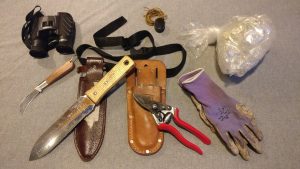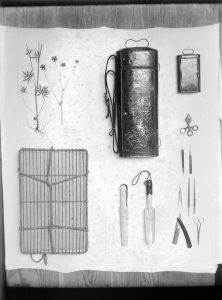
There are a variety of tools and supplies you might need or want depending on the type of specimen you plan to collect. Here is a list of some commonly used items you may want to include in your collecting kit.
Field Tools

- Shovels, trowels, or my favorite Hori; for underground plant materials such as rhizomes, bulbs and roots.
- Secateurs, pruners and hand knives.
- Paint scapers are useful for bryophytes and lichens that adhere to rocks and bark.
- Gloves.
- Hand-lenses (10x and above) for seeing small features of the plant.
- Plastic bags or Ziploc bags to temporarily store plant material.
- Paper bags for large cones, fruits and other large parts of the plants that don’t press well as well as bryophytes, fungi, and lichens.
- Handlens (magnification x10)
Additional Field Supplies

John Davidson’s field kit; City of Vancouver Archives reference number AM505-S1-: CVA 660-663; 1910; BC; Collected by John Davidson
- Waterproof field notebook (even if it doesn’t rain, your precious field notes will be safe from spills and long term mold issues).
- Wooden pencils to record information (not mechanical – wooden pencils are easy to sharpen in the field with your hand knife and mechanical pencils often fail due to sand, dirt and water).
- Plant tags and permanent markers.
- GPS tracking unit to record location and topographic maps (do not rely on smart phone app).
- Altimeter to determine altitude.
- Camera/phone to photograph plants.
- Binoculars so you can ID tree features (opposite or alternate branching); if you turn them around, they can become a small microscope (if you forget your hand lens).
- Download any references, checklist and apps needed for the region you will be collecting in.
